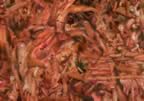Congeries Carnis – 2005
How are we to categorise John Yeadon’s pictures? They evidently stand in the mainstream of the European painting tradition, but in which branch?
I do not think they are examples of the male nude: although they clearly reference Michelangelo as much as Robert Mapplethorpe. They are not portraits. The bodies are partially represented but not individualised, iconic or metonymic. They have ceased to speak of personality and have become as absorbed into formal arrangement as we find in the Inferno illustrations of Gustave Dore.
Their powerful sense of repetition and obsession (something Yeadon says “can’t be faked”) suggests an affinity with the serial paintings of Monet – seemingly endless gallery walls filled with variations on a theme.
Yet these are not repeated depictions of the same object, but merely of similar objects, unless we allow their iconicity to seduce us into thinking of them as referring to some general, abstracted principle such as the Lacanian phallus. They seem to me to resist such a mythologising interpretation. Yeadon’s work is avowedly and uncompromisingly materialist.
Other traditions suggest themselves – perhaps these are collections of found objects, after Duchamp or collages in the manner of John Heartfield. Perhaps, even, they are arrangements of industrially produced objects, following Carl Andre?
In the end, I think, it is the playful, ironically humorous aspect of these pictures that provides the key to an interpretation. It is this that makes them powerful in an utterly unexpected way. One penis is potentially threatening or arousing. Presented in their hundreds, that aura dissolves and they function, not as objects of desire or domination, but as that supreme achievement of realism – the depiction of something in such a way as to re-present it, to show it in a new perspective and compel us to reassess its significance for us.
As capable of endless reinterpretation as Titian’s vast canvases of scenes from classical mythology, these are allegories.
Will Barton, May 2005

